Car body style
Appearance
This article needs additional citations for verification. (April 2019) |
There are many types of car body styles. They vary depending on intended use, market position, location, and the era they were made.
Current styles
[edit]- Buggy
- Lightweight off-road vehicle with sparse bodywork. Originally two- or four-wheeled carriages in the 19th and early 20th centuries pulled by one horse, the motorized buggies were developed in the 1960s and grew in popularity and diversity.[1][2]

- Convertible / cabriolet
- Has a retractable or removable roof. A convertible allows an open-air driving experience, with the ability to provide a roof when required.[3] Most convertible roofs are either a folding textile soft-top or a retractable metal roof. Convertibles with a metal roof are sometimes called 'retractable hardtop', 'coupé convertible', or 'coupé cabriolet'.
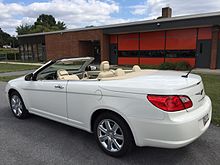
- Coupé
- Two-door car, often seating only two persons and thus a two-passenger car. Some have room for four, or have a tight-spaced rear seat.[4][5]
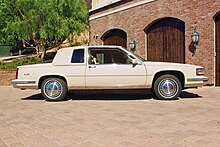
- Fastback
- Car with a roofline that slopes continuously down at the back. The design features a single unbroken convex curve from the roof to the rear.[6][7]

- Flower car
- In the US used in the funeral industry to carry flowers for burial services. Typically a coupé-style, forward-passenger compartment with an open well in the rear.[8]
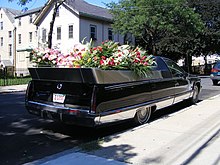
- Hatchback / Liftback
- Car with a hatch-type rear door that is hinged at the roof and opens upwards. The term "hatchback" can also refer to that type of rear door, which is also used on several sports cars, SUVs, and large luxury cars.[9]
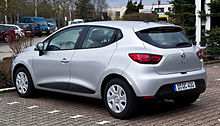
- Hearse / funeral coach
- The modification of a passenger car to provide a long cargo area for carrying a coffin or casket. Hearses often have large glass panels for viewing the coffin.

- Limousine
- A luxury-type vehicle that is typically driven by a chauffeur with a partition between the driver's compartment and the passenger's compartment. Limousines may also be stretched to provide more room in the rear passenger compartment. In some European usage, the word describes a regular four-door sedan body style.

- Microvan
- The smallest size of minivan/MPV.
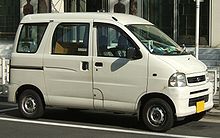
- Minivan / multi-purpose vehicle (MPV) / people carrier / people mover
- Vehicle designed to transport passengers in the rear seating row(s) with reconfigurable seats in two or three rows. Typically has a combined passenger and cargo area, a high roof, a flat floor, a sliding door for rear passengers, and high H-point seating. In Europe, some small minivans have been marketed as 'leisure activity vehicles'.
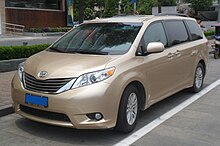
- Panel van / car-derived van / sedan delivery
- A cargo vehicle based upon passenger car chassis and typically has one row of seats with no side windows at the rear. Panel vans are smaller than panel trucks and cargo vans, both of which are built on a truck chassis.

- Panel truck
- A pickup truck that has a fully enclosed truck topper in its back, giving it a van-like appearance.
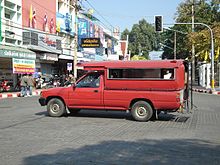
- Pickup truck / pickup
- A light-duty, open-bed truck. In South Africa, a pickup truck is called a "bakkie".[10]

- Roadster
- An open two-seat car with emphasis on sporting appearance or character. Initially, an American term for a two-seat car with no weather protection, usage has spread internationally and has evolved to include two-seat convertibles.
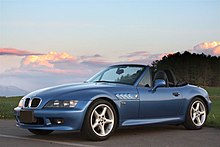
- Sedan / saloon
- A fixed-roof car in a three-box design.[11] These form separate compartments for engine, passenger, and cargo. Sedans can have two or four doors. A sedan is called a "berlina" in Spanish and Italian, or a "berline" in French.

- Shooting-brake
- Initially, a horse-drawn vehicle used to carry shooting parties with their equipment and game; subsequently synonymous with station wagon / estate car; and in contemporary usage a three or five-door wagons combining features of a station wagon and a coupé.

- Station wagon / estate car
- Has a two-box design, a large cargo area, and a rear tailgate that is hinged to open for access to the cargo area. The body style is similar to a hatchback car; however, station wagons are longer and are more likely to have the roofline extended to the rear of the car[9] (resulting in a vertical rear surface to the car) to maximize the cargo space. In French, a station wagon is called a "break".
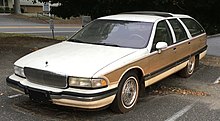
- Targa top
- A semi-convertible style used on some sports cars, featuring a fully removable soft or hard roof panel that leaves the A and B pillars in place on the car body.
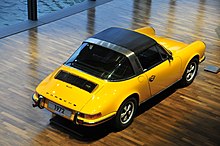
- Ute / coupe utility
- Based on a passenger sedan chassis and has a cargo tray in the rear integrated with the passenger body (as opposed to a pickup truck, which has a separate cargo tray). In Australia, the term "ute" was originally used solely for coupé utility cars; however, in recent years, it has also been used for pickup trucks.

Historic styles
[edit]- Baquet
- Has two rows of raised seats, similar to horse-drawn carriages; usually did not have front doors, a roof, or a windshield. The baquet ("bathtub") style was produced in the early 1900s in Europe.[12]
- Also a marketing term used on cars built in the United States in the 1920s and 1930s.
- Barchetta
- Italian two-seat sports car with either an open-top or convertible roof. The term was originally used for lightweight open-top racing cars from the late 1940s through the 1950s. Since the 1950s, the name barchetta ("little boat" in Italian) has been revived on several occasions, mostly for cars with convertible roofs that are not specifically intended for racing.
- Berlinetta
- Italian sports coupé, typically with two seats but also including 2+2 cars. The original meaning for berlinetta in Italian is "little saloon."
- Cabrio coach
- A retractable textile roof, similar to a convertible/cabriolet. The difference is that where a convertible often has the B-pillar, C-pillar, and other bodywork removed, the cabrio-coach retains all bodywork to the top of the door frames and just replaces the roof skin with a retractable fabric panel.
- Coupé de ville / Sedanca de ville / town car
- An external or open-topped driver's position and an enclosed compartment for passengers. Produced from 1908 until 1939. Although the different terms may have once had specific meanings for certain car manufacturers or countries, the terms are often used interchangeably.
- Some coupé de villes have the passengers separated from the driver in a fully enclosed compartment, while others have a canopy for the passengers and no partition between the driver and the passengers (therefore passengers enter the compartment via the driver's area).
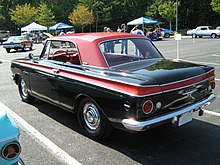
- Hardtop
- Usually describes pillarless hardtops that are cars without a B-pillar often styled to give the appearance of a convertible. Popular in the United States from the mid 1950s through the mid 1970s.[13]
- It also refers to a separate top that is removable and made of metal or other hard material for sports cars or small SUVs.[14]
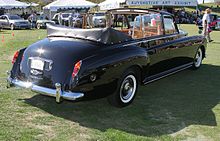
- Landaulet
- A car where the rear passengers are covered by a convertible top. Often the driver is separated from the rear passengers with a partition, as per a limousine.
- Personal luxury car
- American luxury coupés and convertibles produced from 1952 to 2007. The cars prioritized comfort, styling, and a high level of interior features.[15][16]
- Phaeton
- An open-roof automobile without any fixed weather protection, which was popular from the 1900s until the 1930s.[17][18]
- Roadster utility
- An open-topped roadster body and a rear cargo bed.
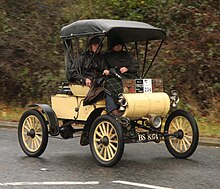
- Runabout
- A light, inexpensive, open car[19] with basic bodywork and no windshield, top, or doors.[19] Most runabouts had just a single row of seats, providing seating for two passengers.[19][20]
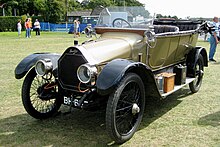
- Torpedo
- Body style was a type of automobile body used from 1908 until the mid-1930s, which had a streamlined profile and a folding or detachable soft top. The design consists of a hood or bonnet line raised to be level with the car's waistline, resulting in a straight beltline from front to back.[21]
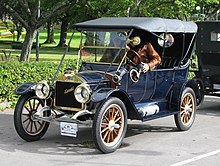
- Touring
- A style of open car built in the United States that seats four or more people. The style was popular from the early 1900s to the 1930s.[22]
See also
[edit]Wikimedia Commons has media related to Automobile body styles.
References
[edit]- ^ Tikkanen, Amy. ""buggy" - carriage". Encyclopedia Britannica. Retrieved 3 January 2023.
- ^ Hale, James (2006). Dune Buggy Phenomenon 2. Veloce. ISBN 9781904788669.
- ^ Nice, Karim (2 May 2001). "How Convertibles Work". auto.howstuffworks.com. Retrieved 3 January 2023.
- ^ "Dictionary: Coupé". Merriam-Webster.com. Retrieved 15 March 2024.
- ^ "Dictionary: coupe". britannica.com. Retrieved 15 March 2024.
- ^ "Dictionary: fastback". dictionary.com. Retrieved 15 March 2024.
- ^ "Dictionary: "Fastback"". Merriam-Webster.com. Retrieved 15 March 2024.
- ^ "Flower Cars: A Glance At A Forgotten Funeral Vehicle". Luxury Coach & Transportation Magazine. 1 January 1990. Archived from the original on 25 April 2019. Retrieved 13 December 2018.
- ^ a b Hillier, Victor; Coombes, Peter (2004). Hillier's Fundamentals of Motor Vehicle Technology: Volume 1 (5th ed.). Nelson Thornes. p. 11. ISBN 9780748780822. Retrieved 15 January 2013.
The estate body, also known as station wagons in some countries, has the roofline extended to the rear of the body to enlarge its internal capacity. Folding the rear seats down gives a large floor area for the carriage of luggage or goods. Stronger suspension springs are fitted at the rear to support the extra load. Hatchback: Although some hatchbacks are in fact saloon bodies with the boot or trunk effectively removed (usually the smaller cars) many hatchbacks retain the full length of the saloon, but the roofline extends down to the end of the vehicle...as with the estate, the rear seats fold down to give a flat floor for the transportation of luggage or other objects. When the tailgate is closed, the luggage compartment is usually covered with a parcel shelf.
- ^ "Bakkie: definition". Oxforddictionaries.com. Archived from the original on 9 May 2013. Retrieved 12 August 2014.
- ^ Torchinsky, Jason (5 April 2018). "This Is Why We Call Cars Sedans, Limousines, And Saloons". Jalopnik. Retrieved 3 January 2023.
- ^ "Body Styles". aaca.org. Archived from the original on 22 March 2019. Retrieved 24 April 2019.
- ^ "A History of Hardtops". Hemmings Classic Car. April 2006. Retrieved 21 April 2022.
- ^ Haajanen, Lennart W. (2017). Illustrated Dictionary of Automobile Body Styles, 2d ed. McFarland. pp. 87–89. ISBN 9780786499182. Retrieved 21 April 2022.
- ^ Glon, Ronan (20 February 2023). "The rise & fall of the personal luxury car". MSN. Retrieved 16 December 2023.
- ^ Gilmore, Ryan (30 January 2021). "Ranking The Greatest Classic American Personal Luxury Cars On The Used Market". HotCars. Retrieved 16 December 2023.
- ^ "Definition of 'phaeton'". Webster's New World College Dictionary, 4th Edition. 2010. Retrieved 16 December 2023.
- ^ Taylor, Thom (16 May 2018). "Sure, phaetons are fabulous; just don't try riding in the back seat". Hagerty. Retrieved 16 December 2023.
- ^ a b c Haajanen 2003, p. 116.
- ^ Clough 1913, p. 258.
- ^ Roberts, Peter (1974). "Carriage to Car". Veteran and Vintage Cars. London, UK: Octopus Books. p. 111. ISBN 0706403312.
Torpedo – Continental term for an open four-seat car with soft hood and sporting tendencies and in which the line of the bonnet was continued back to the rear of the car.
- ^ "Definition of 'touring car'". Webster's New World College Dictionary, 4th Edition. 2010. Retrieved 16 December 2023.
Bibliography
[edit]- Clough, Albert L. (1913). A dictionary of automobile terms. The Horseless Age. LCCN 13003001. Retrieved 3 January 2023 – via Internet Archive.
- Haajanen, Lennart W. (2003). Illustrated Dictionary of Automobile Body Styles. Illustrations by Bertil Nydén and Jörgen Persson. Jefferson, NC: McFarland. ISBN 978-0-7864-1276-1.
